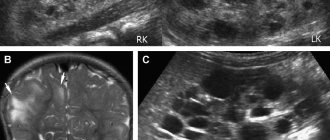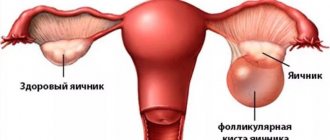Many women do not always know and clearly imagine the processes that occur in their body every month throughout their reproductive years. Many people learn about the formation of the corpus luteum during pregnancy only after they hear or read the results of an ultrasound.
An ultrasound examination, as a result of which a woman makes a discovery about the existence or absence of her corpus luteum, is carried out for various reasons. Someone has the task of confirming pregnancy. Some people just can’t get pregnant and need an ultrasound to check.
Both of them ask questions:
- what it is;
- what condition does its presence indicate?
- what does the change in its size indicate?
- why gynecologists pay so much attention to this indicator;
- what is a corpus luteum cyst, and what is the danger in it.
Corpus luteum: what is it?
Every month, one (less often two) follicle matures in a woman’s ovary, from which a new egg is released. This release of the female reproductive cell is called ovulation.
The corpus luteum of the ovary forms at the site where the egg is released. It is called so because of the yellow pigment it contains - lutein. The corpus luteum itself, or luteal body, is a collection of follicle granulation cells and blood vessels.
So, it is clear that it should form after ovulation, that is, in the II phase of each cycle, in any woman of childbearing age.
https://youtu.be/XwfAisTCcJU
Reasons for the development of a corpus luteum cyst during pregnancy
The essence of the mechanism of formation of a corpus luteum cyst of the ovary is as follows: after ovulation, the follicles stop growing and filling with lutein, but since the walls of the follicles gradually stretch, the latter begin to fill with serous fluid. However, researchers have still not been able to accurately and definitively establish all the reasons for the process of cyst formation. However, experts confidently point to a number of factors that can provoke the appearance of such a cyst:
- presence of hormonal imbalance;
- disruption of the flow of blood and lymph in the corpus luteum - after all, it normally has the most intense blood flow among other organs of the female body;
- severe stress, which provokes the production of excess catecholamines;
- inflammation of the pelvic organs;
- termination of pregnancy (abortion);
- emergency contraception with drugs;
- poor nutrition, for example, mindlessly following extreme diets during pregnancy can weaken the female body, and rapid weight loss can disrupt the menstrual cycle;
- drugs indicated for infertility to stimulate the ovaries, because hormonal drugs can disrupt the endocrine regulation of the ovulation process and interfere with the formation of the corpus luteum;
- if a pregnant woman works in hazardous production conditions, she is at risk of intoxication with harmful substances or exposure to ionizing radiation, which will have an extremely negative impact on her health;
- some infectious diseases associated with the genital organs.
A luteal cyst can only occur during a two-phase menstrual cycle and affects only one of the ovaries. More often, the cyst occurs in multiple pregnancies. One way or another, corpus luteum cysts are always benign tumors.
Development of the corpus luteum?
The corpus luteum is formed under the influence of luteinizing hormone from the pituitary gland. It is designed to solve the problem of preparing a woman’s body for conceiving a child.
The corpus luteum works as a temporary endocrine gland, producing the hormone progesterone - the main guardian of pregnancy in a woman’s body. In the second phase of the cycle, progesterone ensures the preparation of the “fertile layer” of the uterus for implantation of the embryo.
If fertilization does not occur, this gland is no longer needed and it will regress, leaving a delicate white scar in its place. In the literature one can find a definition of this phenomenon as the white body of the ovary. Over time, this small scar disappears.
If the meeting of the egg and sperm ends in fertilization, and the resulting embryo is attached to the wall of the uterus, the corpus luteum continues to function until approximately 10-12 weeks of pregnancy.
The functioning of the luteal body ends when the formed placenta is ready to completely take over the function of producing progesterone. Progesterone at this stage ensures natural growth and neuromuscular calm of the uterus for successful gestation, preparation of the mammary glands and much more.
Useful: Large fetus during pregnancy
Reasons for formation
The corpus luteum is formed in the ovaries under the influence of the pituitary hormone, luteinizing hormone, and is a temporary secretion gland that is formed anew in each menstrual cycle, this is a regular monthly process. At some stage - it is not possible to establish exactly - the corpus luteum begins to fill with serous fluid.
Reasons for development:
- frequent cases of infectious and inflammatory diseases of the reproductive system;
- a history of pregnancy loss;
- hormonal disorders, in particular, fluctuations in the level of sex hormones;
- frequent stress, overwork;
- excess/underweight;
- incorrectly selected contraceptives (usually during the first use or when using a self-selected oral contraceptive).
In the early period, the corpus luteum ensures the normal process of gestation
The exact etiology of this condition has not been identified. The formation of a cystic formation is based on impaired blood and lymph circulation, which leads to the accumulation of aseptic fluid.
Features of the neoplasm:
- the size ranges from 1 to 6 cm (normally the size of the corpus luteum does not exceed 2 cm);
- the cavity of the tumor-like formation is single, without signs of multi-chamber (differential sign);
- as a result of the spontaneous resorption of the corpus luteum, a white body is formed (a residual sign that has no activity in the woman’s body);
- the lipochrome pigment located in the cavity of the gland has a yellowish color.
A cyst discovered during a routine examination of a pregnant woman does not pose a danger to the body. Requires only routine monitoring for 1-2 months.
Does the presence of a corpus luteum always indicate pregnancy?
There is a misconception that the corpus luteum is formed after fertilization. Many people believe that its detection on an ultrasound indicates one hundred percent pregnancy.
From what was stated above in the previous paragraphs of the article, it is already clear that the corpus luteum is formed every month in every woman in the second half of the cycle after ovulation. And its presence during this period of the menstrual cycle can only indicate one thing - that ovulation definitely occurred in this cycle.
Whether fertilization has occurred can be partially determined by further changes in the corpus luteum.
Normally, the size of the corpus luteum is 12-20 mm. By the end of the second phase of the menstrual cycle (before menstruation), if fertilization has not occurred, it decreases in size. If pregnancy occurs, the size increases to 30 mm.
Sizes can indicate a possible pregnancy, especially in the early stages, when other methods of determining pregnancy have not yet given a clear answer.
It happens that a woman has a slight delay in her period, the test is negative, the uterus is enlarged, but the embryo is not visualized on ultrasound. Then it is important to assess the size of the corpus luteum of the ovary. So, if an ultrasound revealed a corpus luteum measuring more than 20 mm with a delay in menstruation, then we can make a preliminary conclusion that pregnancy has occurred.
But, having received such a result, it is still worth repeating the ultrasound on a more modern device or after a couple of days. And also determine the level of human chorionic gonadotropin in venous blood (vein analysis). Based on the results of such additional control, information will be obtained that will allow the gynecologist to confirm or deny the fact of pregnancy.
What should the corpus luteum be like?
Usually the corpus luteum occurs in one ovary: in the one where ovulation occurred, less often there are two corpus luteum, one in each ovary.
The corpus luteum is usually clearly “visible” on an ultrasound. His condition must be assessed during the first visits to the gynecologist and at all subsequent examinations while it is visible. It can be seen both with intravaginal ultrasound and with traditional ultrasound. In order to secrete a sufficient amount of hormones, the corpus luteum must be of a certain size. The normal size during pregnancy is considered to be from 10 to 30 mm in diameter - approximately the size of a cherry. If we talk about weeks of pregnancy, then there are the following standards:
- On the 21st day of the obstetric period (from the first day of the last menstruation), a size of 15–20 mm is considered the norm.
- Up to 16 weeks, its size should vary between 25–30 mm.
Then the gland shrinks and gradually disappears.
The normal size of the corpus luteum during pregnancy is only an indirect sign that it is working well and secretes enough hormones. To avoid miscarriage or fading of pregnancy, a competent doctor should pay attention to other factors, for example, assess how well the fertilized egg is attached to the uterine cavity.
The most informative indicator is the level of progesterone in the blood, determined by laboratory analysis.
If the size of the corpus luteum differs from the norm, we can talk about either glandular insufficiency or a cyst. In this case, the doctor usually prescribes the woman an additional source of progesterone - drugs such as Utrozhestan or Duphaston.
Deficiency during pregnancy
When a woman initially has hypofunction of the corpus luteum, she experiences difficulty conceiving a child. It is known that among the various reasons for the inability to conceive and bear a child, the main reason is the lack of progesterone production by the corpus luteum.
Before pregnancy, a lack of progesterone production can manifest itself as persistently irregular cycles, frequent and prolonged delays and scanty menstruation.
During pregnancy, a deficiency of this hormone is manifested by increased tone of the uterus, often light spotting (in the form of spotting), and nagging pain in the lower abdomen. When performing an ultrasound, such women are often diagnosed with partial placental abruption.
Helpful: First sensations during pregnancy: symptoms and timing of their appearance
Considering the dominant role of progesterone in preparing a woman’s body for pregnancy, it becomes clear that if there is insufficient amount of progesterone, it is simply not possible to ensure implantation of the embryo into the uterus and normal development of the fetus.
As a consequence, insufficiency of the corpus luteum can lead to early miscarriage or frozen pregnancy. Timely diagnosis and treatment of a lack of progesterone production by the corpus luteum allows you to avoid these troubles during pregnancy.
The first test for hypofunction of the corpus luteum is to identify its size on ultrasound. If the ultrasound showed a small corpus luteum (about 10 mm), this is the first evidence of a violation of its function. But it is wrong to draw a conclusion only on this basis. It is necessary to additionally do an analysis of the level of progesterone in the blood.
If hypofunction of the corpus luteum is confirmed, so-called replacement therapy is prescribed. That is, a woman is injected with a hormone from the outside. For this purpose, both tablet and injectable drugs can be used. Preference is given, of course, to tablets, but in cases where emergency assistance is required and a rapid increase in progesterone levels is necessary, intramuscular administration of the drug is prescribed.
Examples of drugs containing synthetic progesterone are Duphaston, Dydrogesterone. There is also a herbal preparation - Utrozhestan - which can be used orally (by mouth) and intravaginally. The choice of method of application is important if a woman has toxicosis in the early stages.
The duration of such replacement therapy varies, since it can be prescribed in different cases (both pregnant women and women planning pregnancy) and depends on the indications for which such therapy is prescribed.
During pregnancy, on average, treatment for progesterone deficiency lasts up to 12-13 weeks of pregnancy (less often up to 15 weeks). At this time, the functioning of the corpus luteum ends and the placenta takes over the production of progesterone. Monitoring the level of progesterone in the blood of women with this problem continues in later stages of pregnancy.
Symptoms of ovarian corpus luteum cyst
Cystic formation can develop asymptomatically, in some cases it is manifested by a feeling of fullness, heaviness in the abdomen, mild pain and discomfort. There may be a delay in menstruation due to a corpus luteum cyst, or a prolonged period of menstruation.
Severe symptoms appear in the complicated course of tumor formation:
- Complete or partial torsion of the ovarian pedicle. This complication causes compression of the nerves and blood vessels of the organ, disrupting nutrition and blood circulation in the organ. The corpus luteum cyst is very painful, the pain syndrome is of an acute, stabbing nature. The condition is accompanied by a decrease in blood pressure, general weakness, attacks of dizziness, and nausea. In some cases, there is an increase in temperature and disruption of the intestines (constipation). The pathological condition occurs as a result of the growth of the cyst to a large size exceeding 5 cm. Twisting of the organ pedicle requires immediate surgery;
- Menstruation disorders. In most cases, the disorder manifests itself as delayed menstruation. The condition occurs due to the active influence of progesterone synthesized by the gland. Activation of the hormone leads to later rejection of the mucous membrane in the uterine cavity, which provokes a delay in menstruation. The duration of the delay, with the development of a hollow formation, can reach up to 2 weeks;
- Rupture of an ovarian cyst of the corpus luteum occurs infrequently. It manifests itself with severe symptoms: a sharp pain permeates the lower abdomen, which does not subside when the body position changes. Accompanying symptoms are nausea and vomiting, attacks of dizziness, lightheadedness, severe weakness, and cold sweat. The temperature does not rise.
Emergency surgical intervention is required if, when the cyst ruptures, bleeding occurs into the pelvic cavity or peritoneum. The main manifestations of the condition: shock, weakness, lethargy. Blood pressure drops sharply, heart rate increases, and the skin turns pale.










